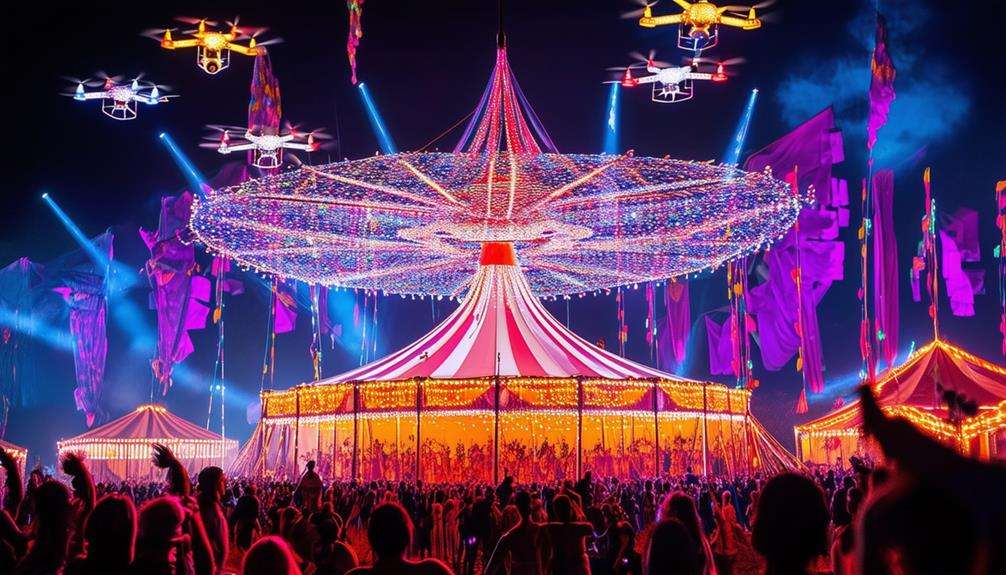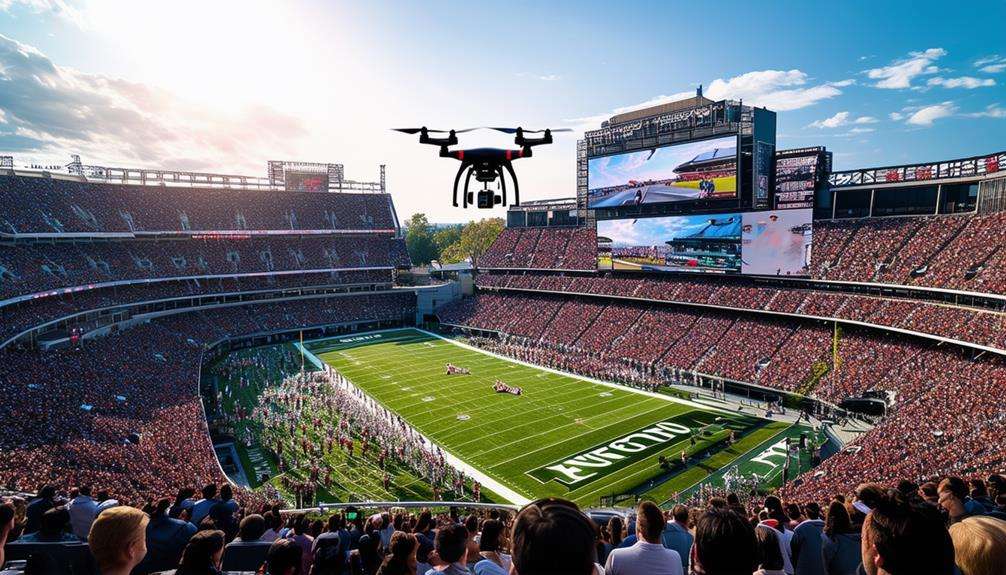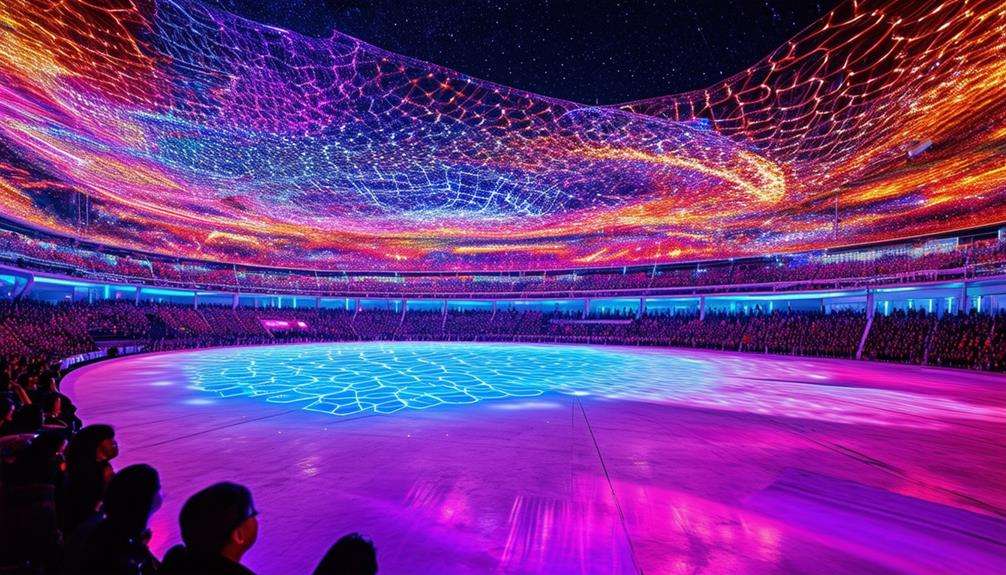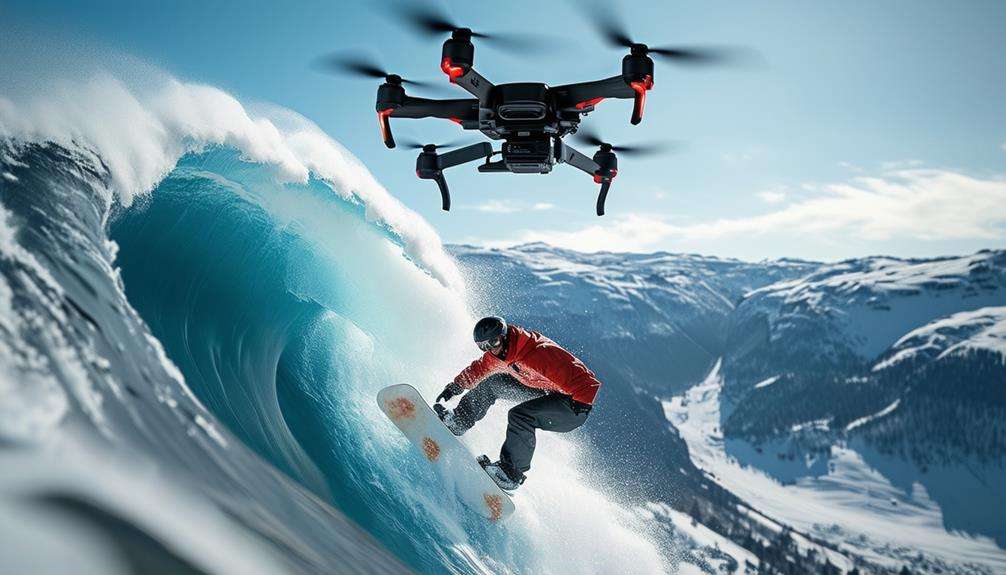What Are Drones Used for in Entertainment?
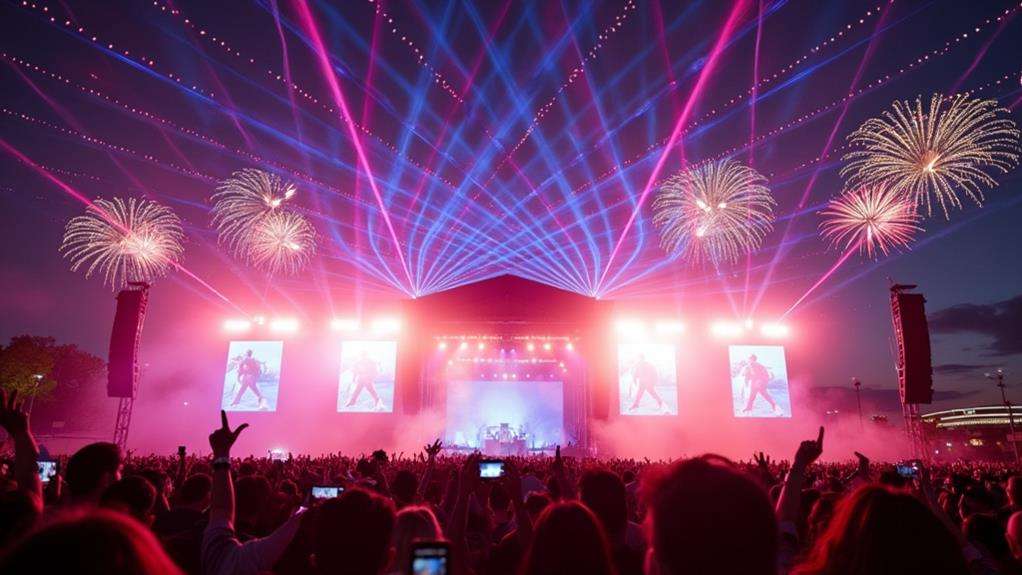
Imagine you're watching a breathtaking action film, and suddenly, the camera swoops through narrow city streets, capturing every detail from above. That's the magic of drones in entertainment. These versatile tools aren't just for stunning aerial shots in movies; they're revolutionizing music videos, live events, and even sports coverage. By providing unique perspectives and dynamic angles, drones elevate visual storytelling to new heights. But there's more to their role than just capturing beautiful footage. Curious about the full spectrum of drone capabilities in entertainment? Let's explore how they're shaping the industry in ways you might not expect.
The Evolution of Drone Filmmaking
The evolution of drone filmmaking has revolutionized aerial cinematography, making it more accessible and affordable. Drone technology allows filmmakers to capture stunning aerial footage without relying on costly helicopters and cranes, significantly lowering production costs. High-quality shots can now be achieved at a fraction of the traditional expense, enabling more budget-friendly productions.
Drones have democratized aerial cinematography by cutting production budgets substantially. Filmmakers can capture breathtaking landscapes and dynamic action sequences for just 25% of what it previously cost. This affordability empowers independent filmmakers to explore creative avenues that were once financially out of reach.
Advanced stabilization technology in drones ensures smooth, professional footage, enhancing the overall quality of projects. Filmmakers can easily capture innovative tracking shots and dynamic scenes, elevating their storytelling. Additionally, drones provide access to previously unreachable filming locations, offering unique perspectives that enrich visual narratives.
The growing demand for drone technology in media is evident, with the global commercial drone market booming. As this market expands, so do the opportunities to harness this cutting-edge tool for revolutionary aerial photography and filmmaking.
Key Advantages of Drone Cinematography
Drone cinematography offers remarkable cost and time efficiency, with rental expenses significantly lower than traditional filming methods. Advanced stabilization technology ensures smooth, professional-quality shots, enhancing the overall production value. Additionally, drones provide unique creative opportunities by accessing previously unreachable locations, introducing fresh perspectives to your storytelling.
Cost and Time Efficiency
Filmmakers often grapple with the challenge of producing high-quality content within the constraints of limited budgets and tight schedules. Drone technology has revolutionized the industry by offering a cost-effective and time-efficient alternative to traditional aerial filming methods. Renting a drone typically costs only 25% of what traditional methods like helicopters and cranes would require, making professional aerial shots accessible even to independent filmmakers with limited resources.
In addition to being affordable, drones significantly reduce setup times compared to conventional methods. This allows for the rapid capture of stunning scenes, freeing up valuable time for other creative aspects of production. Drones also offer unparalleled flexibility, easily reaching difficult or remote locations and minimizing logistical challenges. Advanced stabilization technology ensures smooth, professional-quality shots, often reducing the need for extensive post-production work.
| Traditional Methods | Drone Operations |
|---|---|
| High rental costs | 25% of traditional costs |
| Long setup times | Quick setup |
| Logistical challenges | Flexible and mobile |
| Extensive post-production | Minimal post-production |
Embrace drone cinematography to maximize efficiency and keep your projects on budget and on schedule.
Creative Filming Opportunities
Drone cinematography has revolutionized creative filming opportunities, introducing possibilities that were previously unattainable. In the entertainment industry, drones offer a cost-effective alternative to traditional aerial filming methods, reducing rental expenses to as little as 25% compared to helicopters and cranes. This affordability doesn't sacrifice quality; advanced stabilization technology guarantees smooth, professional shots. With drones, you can effortlessly capture dynamic action sequences and breathtaking landscapes, elevating your visual storytelling to new heights.
The flexibility of drones allows access to hard-to-reach or remote locations, enabling unique angles and perspectives that were once impractical. Imagine shooting a suspenseful aerial view in a horror film or adding stunning visual appeal to a music video. Drones make these creative visions possible.
High-speed chase sequences are another area where drones excel, offering precision and fluidity from heights of up to 200 feet above ground. This capability expands your creative boundaries, enabling the realization of thrilling, dynamic scenes. With drones, you're not just filming; you're exploring new realms of visual storytelling in the entertainment world.
Aerial Shots and Dynamic Angles
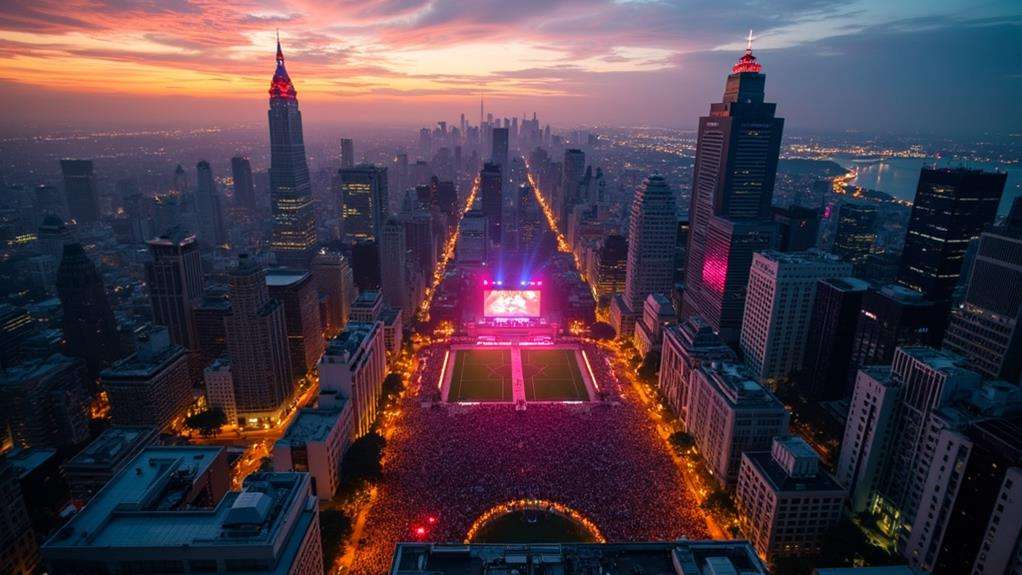
Drones have revolutionized filmmaking by enabling the capture of aerial shots and dynamic angles, thus transforming visual storytelling. With drones, filmmakers can now film breathtaking aerial views of vast landscapes and bustling cityscapes, which were previously difficult to achieve with traditional methods. These devices are equipped with advanced stabilization technology, ensuring smooth and professional footage, ideal for fluid motion scenes.
| Feature | Benefit |
|---|---|
| Advanced Stabilization | Smooth, professional footage |
| Remote Accessibility | Unique angles, creative shots |
| Innovative Perspectives | Unfeasible ground-based angles |
The versatility of drones allows filmmakers to reach remote or difficult filming locations, expanding creative possibilities. Imagine capturing the misty peaks of mountains or the vibrant life of a crowded city from above—drones make these shots possible.
Additionally, drones offer innovative tracking shots, enabling creative possibilities unattainable with ground-based cameras. Their unique perspectives are especially valuable in genres like horror, where aerial views can heighten suspense and immerse the audience.
Action Sequences and Stunts
Drones are revolutionizing the filming of action sequences and stunts by providing unique perspectives that traditional cameras can't achieve. They enable dynamic shots, such as high-speed chases, which are difficult with conventional methods. With advanced stabilization technology, drones deliver smooth, professional-grade footage even during fast-paced movements and stunts, enhancing the visual appeal of action scenes.
These devices can access tight spaces and difficult terrains, offering angles and perspectives that expand creative possibilities in action choreography. Whether navigating narrow alleyways or capturing chases through rugged landscapes, drones handle these challenges with ease.
Moreover, drones can fly at various heights and speeds, allowing filmmakers to capture thrilling aerial maneuvers and stunts, adding excitement and drama to the narrative. Many major films have successfully integrated drone technology into their action sequences, showcasing its effectiveness in capturing breathtaking visuals. By incorporating drones, you're not just filming stunts; you're elevating your storytelling to new heights.
Drones in Music Videos
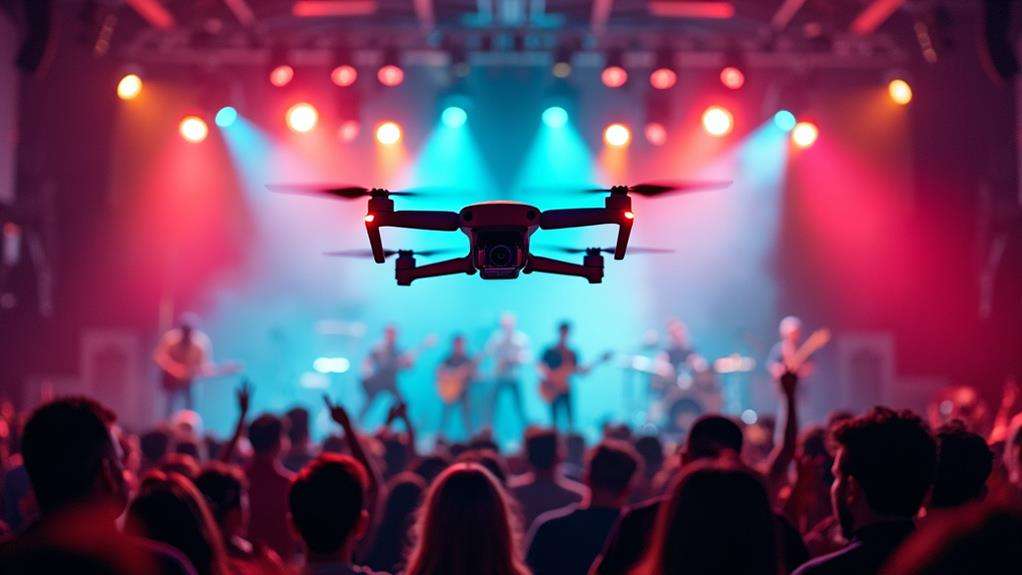
Modern music videos frequently use drones to capture unique aerial perspectives, making visuals more compelling. They enhance narratives by showcasing artists in stunning landscapes and adding depth to the story. Additionally, drones enable dynamic movement shots, resulting in fluid transitions and engaging scenes that are challenging to achieve with traditional methods.
Unique Aerial Perspectives
Imagine soaring above vibrant cityscapes or gliding through vast, untouched landscapes—all within the span of a single music video. Drones provide unique aerial perspectives that capture stunning overhead shots unattainable by traditional filming methods. Skilled drone pilots make this possible, featuring dynamic movements like sweeping panoramas and intricate tracking shots.
Consider the music videos for "Wake Me Up" by Avicii and "Blinding Lights" by The Weeknd. Both utilize breathtaking aerial cinematography to enhance their visual narratives, taking viewers on a journey through diverse and visually captivating settings. Drones can access remote or difficult-to-reach locations, adding depth and creativity to storytelling.
This integration of drone technology in music videos is more than a passing trend; it's becoming a standard in the entertainment industry. Audiences now expect these unique aerial shots to elevate the overall experience. By leveraging drones, artists can push the boundaries of visual storytelling, presenting their music in innovative and immersive ways. Whether it's a sweeping cityscape or an untouched natural environment, drones make it all possible.
Enhanced Visual Narratives
Drones' capability to capture stunning aerial shots has revolutionized music videos, enhancing their visual narratives like never before. When you watch a music video, you're often captivated by expansive landscapes or urban settings that seem vibrantly alive. This is largely due to high-quality drone footage that allows artists to create dynamic, visually engaging sequences. These enhanced visuals elevate the overall production value, making each frame more compelling and immersive.
Consider the sweeping aerial views in Avicii's "Wake Me Up" or the mesmerizing shots in Sia's "The Greatest." These music videos owe much of their visual appeal to innovative drone cinematography. Drones enable unique perspectives and angles, facilitating creative tracking shots that were once impossible to achieve. This adds layers of depth and intrigue to the storytelling, keeping viewers engaged.
Moreover, drones make the filming process more efficient. They allow for quicker setups and seamless transitions between shots, giving directors the freedom to explore creative concepts without logistical constraints. This efficiency opens up new realms of artistic possibilities, ensuring that music videos continue to push the boundaries of visual storytelling.
Dynamic Movement Shots
The magic of dynamic movement shots in music videos lies in their ability to capture breathtaking aerial perspectives, thereby elevating visual storytelling. Drones have revolutionized the entertainment industry by offering sweeping views that were once impossible or prohibitively expensive to achieve. With drones, you can create visually stunning and engaging content that captivates viewers.
Drones enable intricate flight paths, allowing you to follow artists as they navigate diverse landscapes or elaborate set designs. This flexibility adds a new dimension to your music videos, making them more dynamic and visually captivating. High-quality stabilization technology ensures smooth footage even during fast-paced action, ideal for capturing high-energy performances.
Notable music videos by artists such as Drake and Coldplay have utilized drones to create compelling visuals that enhance the song's narrative. As the demand for innovative visuals continues to grow in the entertainment industry, integrating drones into music video production offers numerous benefits:
- Sweeping aerial perspectives
- Creative tracking shots
- Smooth, high-quality footage
Live Events and Sports Coverage
Ever wondered how sports broadcasts have become so captivating? Flying drones are revolutionizing live sports coverage by providing unique aerial perspectives that enhance your viewing experience. These drones capture dynamic action sequences in real time, making you feel like you're right in the middle of the action.
By offering real-time visuals during sporting events, drones allow broadcasters to create immersive experiences. They showcase not only the game but also the surrounding environment and crowd dynamics. This integration of drones has led to innovative filming techniques, such as tracking fast-moving athletes or vehicles, something traditional cameras struggled with.
Major events like the Super Bowl and the Olympics have embraced drones for their aerial shots. This not only enhances production quality but also provides unprecedented views of the venues and events. Extreme sports like snowboarding and surfing also benefit from drones, capturing breathtaking moments that resonate with adventure enthusiasts.
Here's a quick comparison to highlight the advantages of using drones in sports coverage:
| Traditional Cameras | Flying Drones |
|---|---|
| Fixed angles | Dynamic angles |
| Limited mobility | High mobility |
| Ground-level views | Aerial views |
| Static perspectives | Real-time action tracking |
| Standard visuals | Immersive visuals |
With drones, live sports coverage has never been more compelling.
Regulatory and Safety Considerations
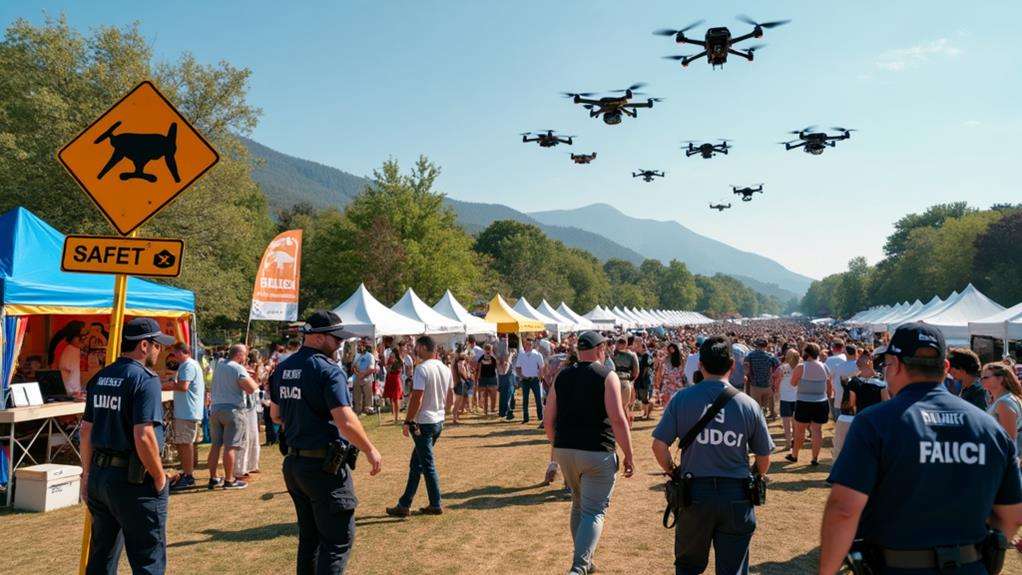
Navigating the regulatory and safety landscape is crucial for drone operators in the entertainment industry. Regulations can vary by country, and obtaining specific permits for aerial filming is often mandatory. For example, the FAA requires commercial drone pilots to have appropriate certifications and follow stringent safety protocols to ensure safe operations during filming.
To maintain safety for crew members and bystanders, thorough pre-flight checks and risk assessments are essential. Compliance with local laws and restrictions, such as no-fly zones near airports or densely populated areas, is mandatory to avoid legal issues and ensure safety while filming in various locations.
Key points to consider:
- Certifications and Permits: Ensure you have the necessary certifications and permits for drone operations in your filming area.
- Weather Monitoring: Check weather conditions before each shoot, as adverse weather can impact drone capabilities and safety.
- Pre-Flight Safety Checks: Conduct comprehensive pre-flight checks and risk assessments to ensure all safety protocols are in place.
Technical Limitations and Solutions
When using drones in entertainment, several technical limitations require creative solutions. A primary constraint is limited flight time, typically ranging from 20 to 30 minutes. Overcoming this necessitates meticulous planning and scheduling to capture all necessary footage within the battery's lifespan.
Another significant limitation is payload capacity, which can restrict the type of camera equipment you can use. Many consumer drones only support lightweight cameras. For high-end gear, heavy-lifter drones are necessary, making the balance between weight and performance a critical factor.
Weather conditions present another challenge, as wind and rain can significantly impact a drone's stability and performance. Close monitoring of weather forecasts before filming is essential to avoid disruptions.
Advanced camera stabilization technology, such as gimbals, is crucial for obtaining smooth shots but adds complexity and weight. Choosing a drone that can handle this extra load without compromising stability is vital.
Lastly, integrating augmented reality tools can help visualize shots in real time. This technology allows for on-the-fly adjustments, providing a clearer picture of the final footage and helping to overcome some technical limitations. As technology advances, these challenges become more manageable, but they still require careful consideration.
Future Trends in Drone Technology
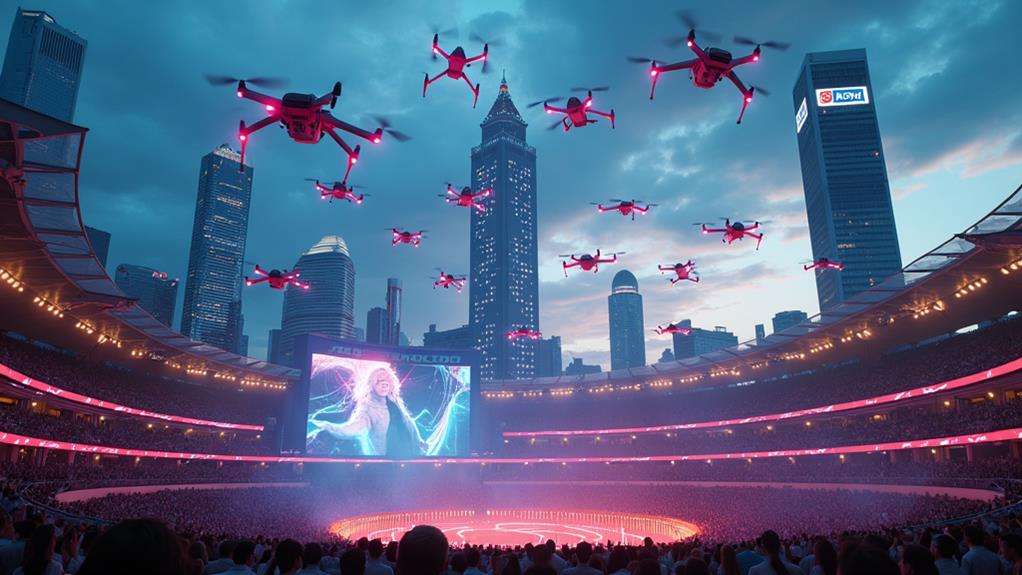
As the technical limitations of drones in entertainment are overcome, transformative trends in drone technology are set to revolutionize the industry. Imagine drones with extended flight times and high-resolution cameras capturing stunning aerial footage, enhancing movie scenes, concert visuals, and sports broadcasts. These advancements will enable dynamic and immersive content like never before.
Key trends to watch include:
- Integration with VR and AR: Drones combined with virtual reality (VR) and augmented reality (AR) will offer immersive storytelling experiences, surpassing traditional media boundaries.
- Real-time live streaming: Enhanced live streaming capabilities will allow drones to provide unique, real-time perspectives of events, making you feel part of the action regardless of your location.
- New entertainment formats: Innovations like drone light shows and aerial performances may soon replace traditional entertainment methods, offering a modern, captivating alternative to fireworks and stage shows.
The increasing demand for skilled drone operators also means more job opportunities in the entertainment sector. Continuous innovation in drone technology promises to amaze and entertain in unprecedented ways.

